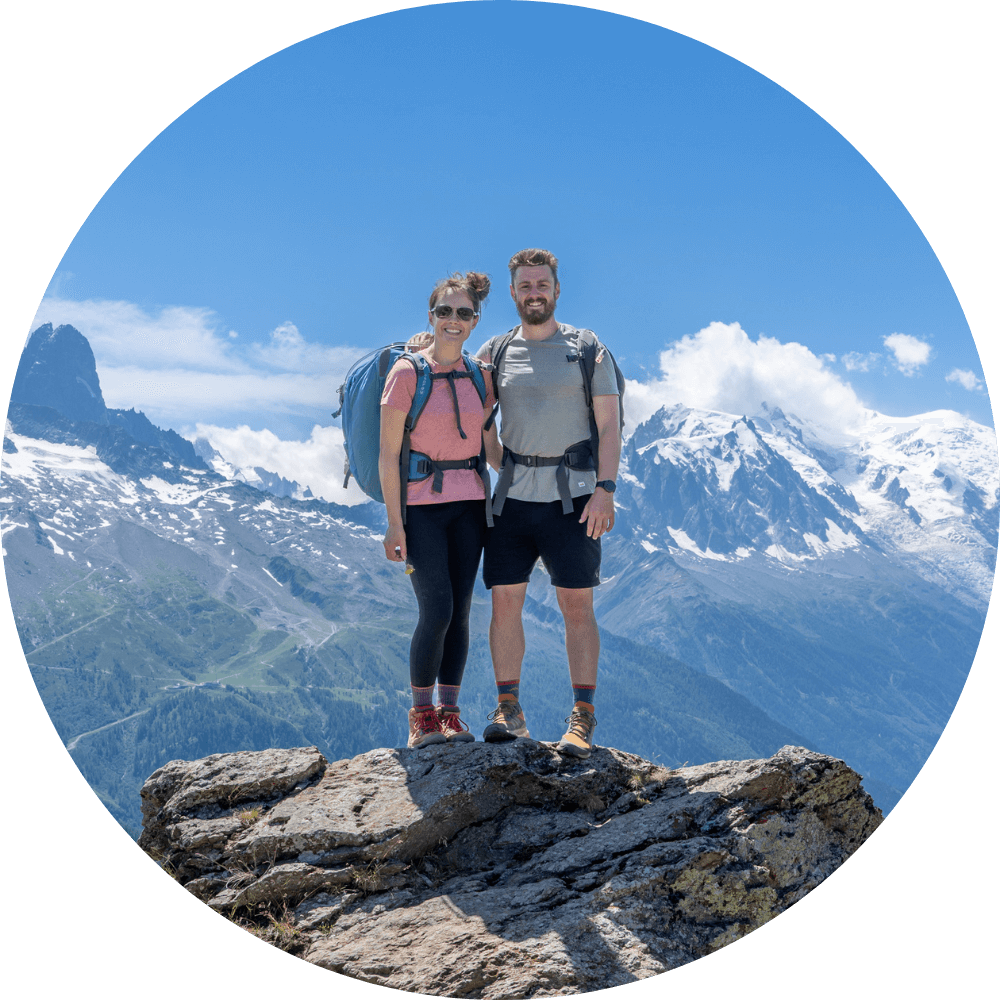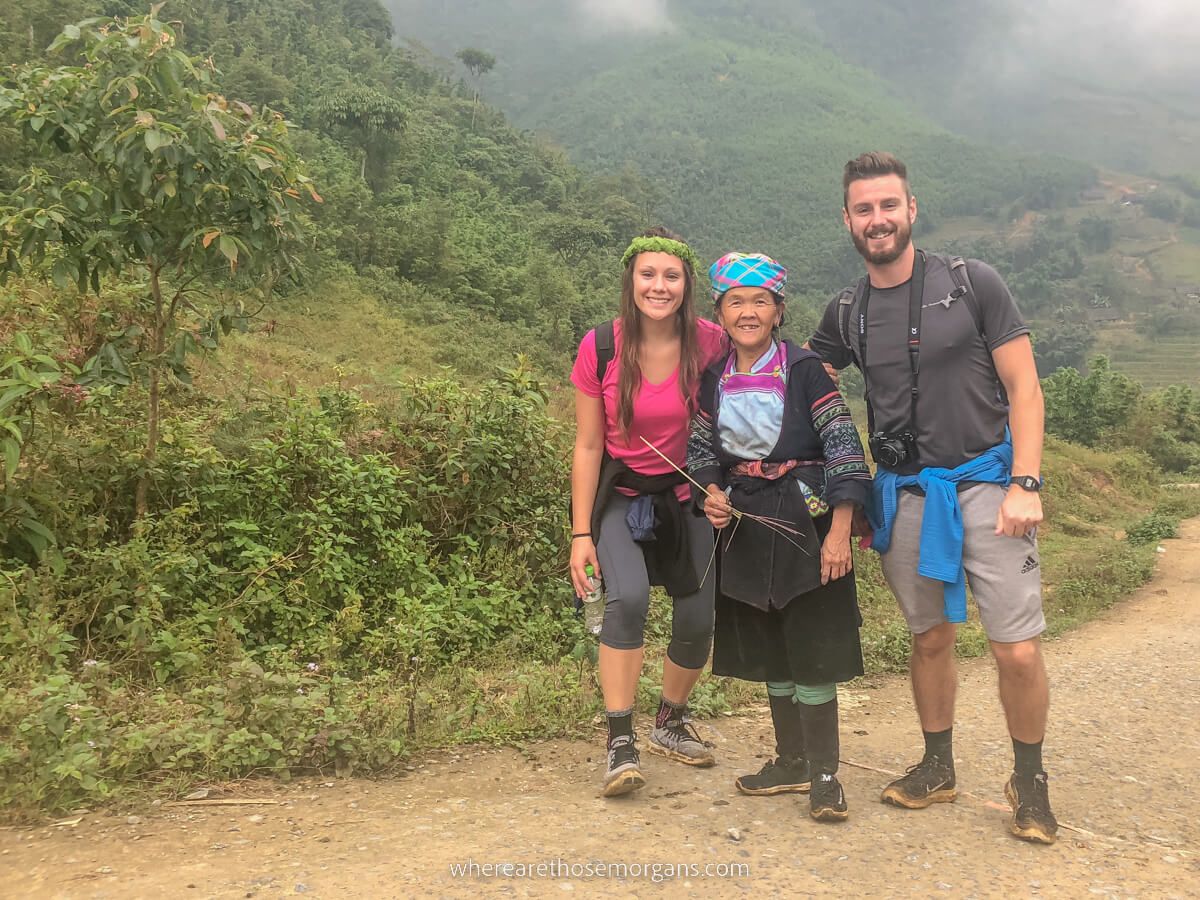Imagine trekking through picturesque terraced rice paddies surrounded by rolling hills and valleys as far as the eye can see. Sounds pretty awesome right? Well, that’s exactly what you can do in Sapa, Vietnam. In this guide we share our honest opinions after our 2 days and 1 night trek in Sapa. We’ll tell you what we liked and didn’t like, along with tips for your trip based on our experiences.
We stayed in Sapa for 4 days in October 2018 as part of our 30-day trip to Vietnam, which we decided to do slowly rather than rushing through. Sapa was difficult to get to because it’s so far north and we can tell you from experience the travel day isn’t fun. Many travelers skip it if they’re short on time, but it’s a lovely place and we do think it’s worth the effort.
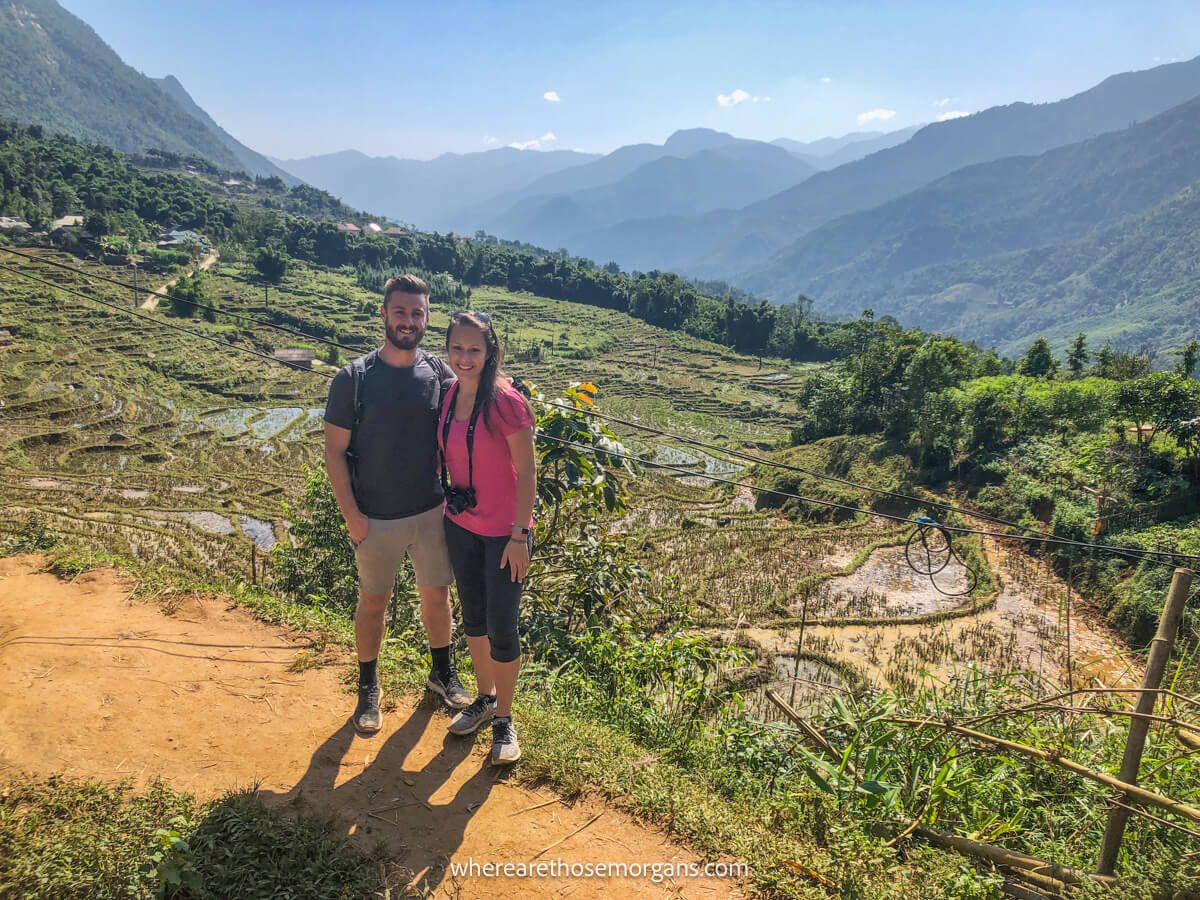
Tourism in Sapa has increased dramatically over the last decade, which is both good and bad. On one hand it helps the local communities, but on the other hand travelers complain about pollution, trash, lack of authenticity and forced shopping experiences. We think social media is partly to blame because it paints a false picture of what you’ll experience in town. Manage your expectations and remember the reasons you’re visiting.
We wanted to tell you this in the beginning of our guide because it’s easy to be disappointed with Sapa, especially if the weather and season aren’t on your side. Remember, those rice paddies are only golden in September and October. Our goal is to help you have the best experience in Sapa, so you leave feeling like you made the most of your trek with a local tribe. Read more about us.
Note: This article may contain affiliate links. If you make a purchase using one of these affiliate links, we may earn a small commission at no extra cost to you. Thank you!
Visiting Sapa
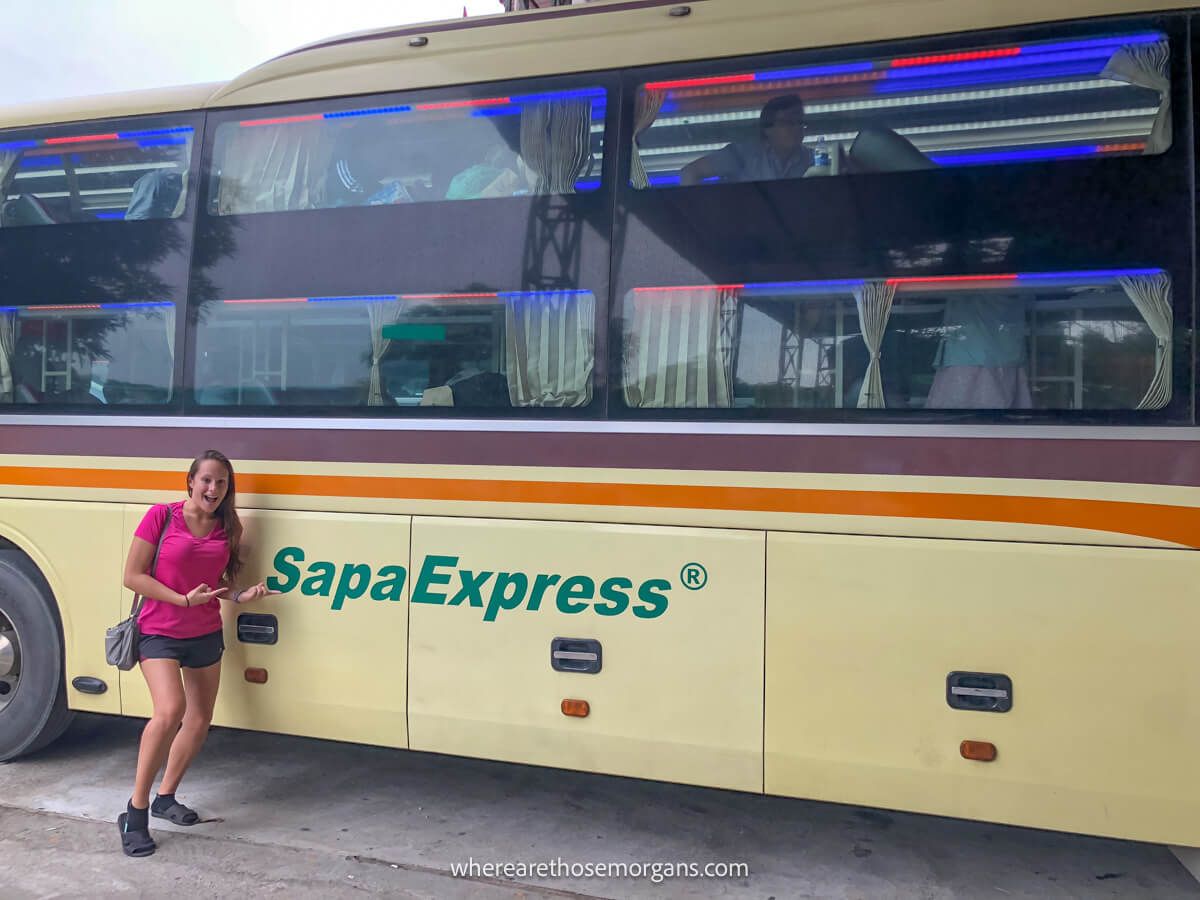
Vietnam’s northwest mountain town of Sapa is located on the slopes of the Hong Lien Son Mountains close to the border with China. It’s nestled among scenic rice terraces and surrounded by various villages filled with ethnic groups who wear beautifully colored clothing.
The tiny mountain town has been attracting hikers for hundred years since the French developed the area in the early 1900’s as a weekend retreat from the humidity of Hanoi. It’s emerged over the last decade as a must visit tourist destination on the typical Vietnam itinerary and hiking is by far the best way to see the beauty of this secluded mountainous region.
Trekking through the stunning Muong Hoa Valley and spending a night at a homestay is one of the most popular things to do in Sapa. But we think you’ll need at least one more day to visit Fansipan, the tallest mountain in the Indochinese Peninsula. Cat Cat village is another highlight, but we don’t think it’s a must see and can be missed. If you’re planning to visit, we recommend reading our guide on the best things to do in Sapa which includes an example itinerary too.
But getting to Sapa is no easy feat. Mountain towns usually mean long winding roads and trust us, Sapa is no exception.
The route from Hanoi to Sapa by bus and train are very similar. Both routes meet in a town on the border with China called Lao Cai. From Lao Cai, there is only one road up and down the mountain to Sapa. See the winding road up the mountain above? The road bends, curves and meanders its way up for what feels like an eternity.
Let’s just say you’ll be given paper bags in case of an emergency on the bus. Our map above shows the location of the Sapa Express bus departure in old quarter Hanoi, Lao Cai and Hanoi train stations. We’ve also marked the Sapa drop off point.
Check prices on 12Go Asia to see whether the train or Sapa Express is a better fit for your budget and schedule. Both the bus and train were priced at US $12 per person when we visited Sapa, but remember you’ll have to pay for a bus connection if you take the train.
Our recommendation is to travel with the Sapa Express. Ironically, despite the barf inducing roads up the mountain, this was the best sleeper bus we took in Vietnam. Personally, we didn’t see the benefit to traveling by train and changing in Lao Cai, especially when the bus was the same price. Plus, the bus left Hanoi closer to where we were staying in the old quarter.
Best Time For Hiking In Sapa
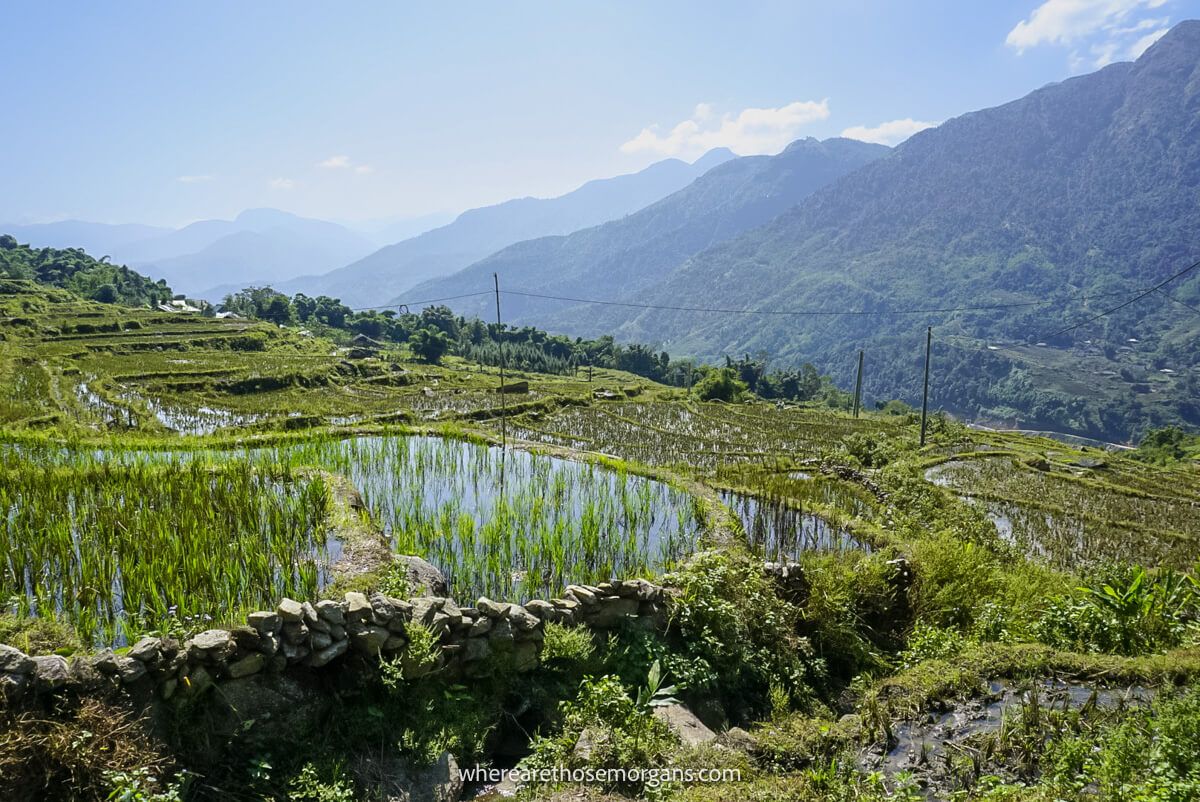
Vietnam is a whirlwind of varying climates. Sapa has a unique subtropical highland climate and it’s common to experience all four seasons in one day. So there’s no way you can plan your entire Vietnam trip based around perfect weather conditions in each city. That being said, if you want the best chance of perfect trekking conditions, September is the month you need to plan for.
Let’s take a look at the seasons:
Fall (September to November)
The weather in the autumn season is cooler and drier compared to the rest of the year with temperatures ranging from 10-20°C (50-68°F). It offers clear skies, ideal temperatures for hiking and golden rice terraces when they’re at their most picturesque.
September is the ideal time to visit. It might still be on the back end of heavy rainfall, but it’s the only time of the year you’ll see the famous and sought after golden rice fields.
By October, most of the harvest has been collected. We hiked towards the end of October and had a mix of clear skies then rain. Unfortunately, the rice paddies were totally waterlogged. By November, it begins to get colder and the rice fields are significantly less attractive.
Winter (December to February)
During the winter, temperatures plummet and fog moves in across the mountains with temperatures ranging from 0-10°C (32-50°F). Snow often falls on the highest peaks and in general, average temperatures are not ideal for hiking.
It’s very cold at night and you’ll have to be prepared for harsh weather conditions. But this is the low season for tourism so you’ll experience cheaper prices and fewer crowds.
Spring (March to May)
Another great time to visit Sapa is the spring season because it’s warm and dry with temperatures ranging from 15-25°C (59-77°F). You’ll also be able to admire flowers blossoming throughout the valleys and hillsides in town. But you won’t see the picturesque golden rice terraces and that’s the main trade off.
This is the time of year when the terraced fields are green with rice seeds and filled with farmers cultivating the rice. It’s a popular time to visit so you can also expect higher prices and more crowds.
Summer (June to August)
The summer season is a popular time for domestic tourism in Sapa. It’s also extremely humid, hot and wet with temperatures ranging from 20-30°C (69-86°F).
This is the time of year when rice terraces are lush green, but you might spend your whole visit being rained on. The air can also be dusty, hazy and visibility can be quite poor which is not ideal for hiking.
Our Sapa Trekking Tour With Hmong Guide
Next, we’ll walk you through exactly what we experienced trekking in Sapa with a local guide for 2 days and 1 night with our photos. Overall, we had a good experience, but there were a few things we didn’t like which we’ll point out.
There are also a few ways you can book a trek and we’ll discuss this later in the guide. We ended up booking through our hotel because we really liked the owners and they let us leave our luggage so we only had to carry a small overnight bag.
Now, let’s hike through Sapa’s picturesque mountains:
Trek Day 1
Early in the morning, we were met by our Hmong trekking guide, Mama Sung right in our hotel lobby. Once the introductions were over, we immediately began our hike.
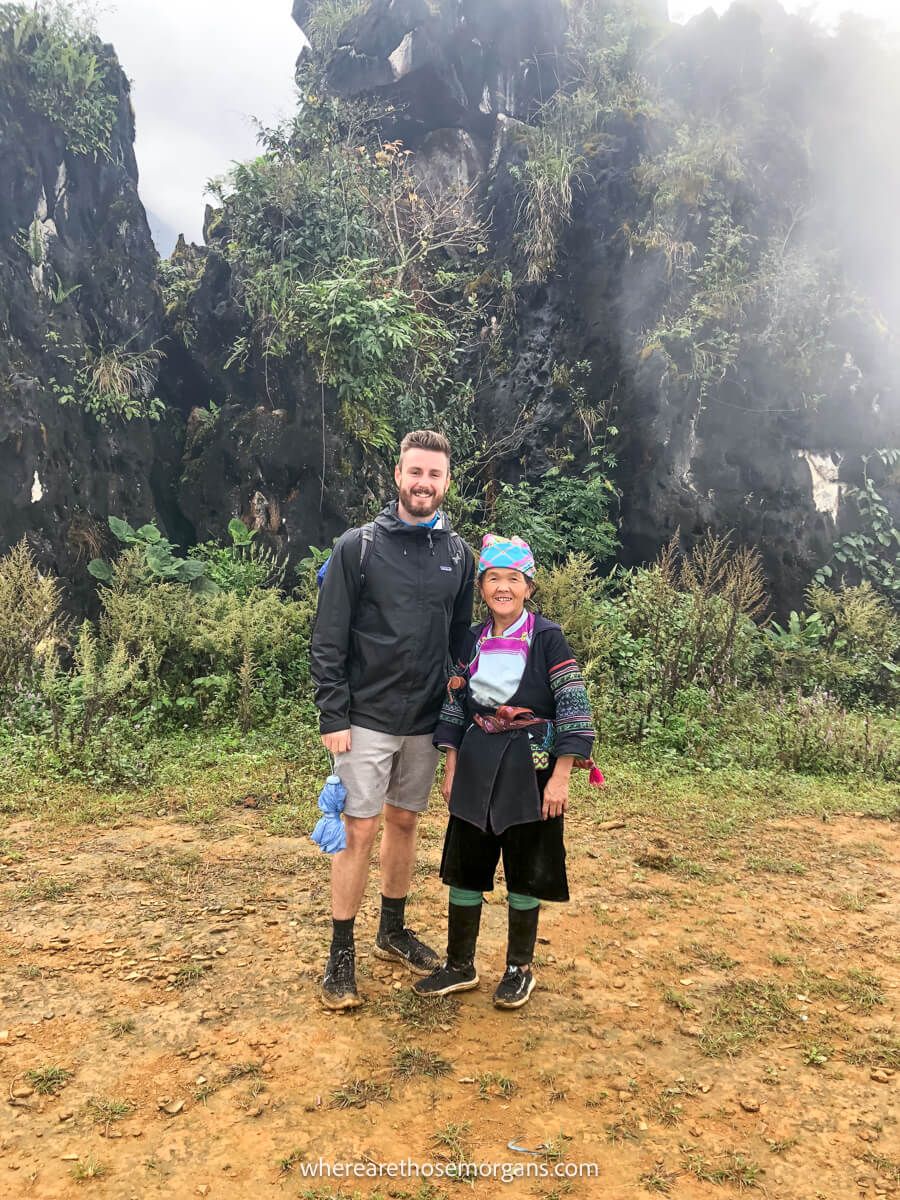
We left town heading east and made our way along dirt paths around mountain sides, passing houses and tons of animals. Heat and humidity took their toll immediately after we began to climb. There are several viewpoints along the route affording spectacular views over valleys and rice terraces. But we were a little unfortunate on our first day as the air was thick with a dense fog.
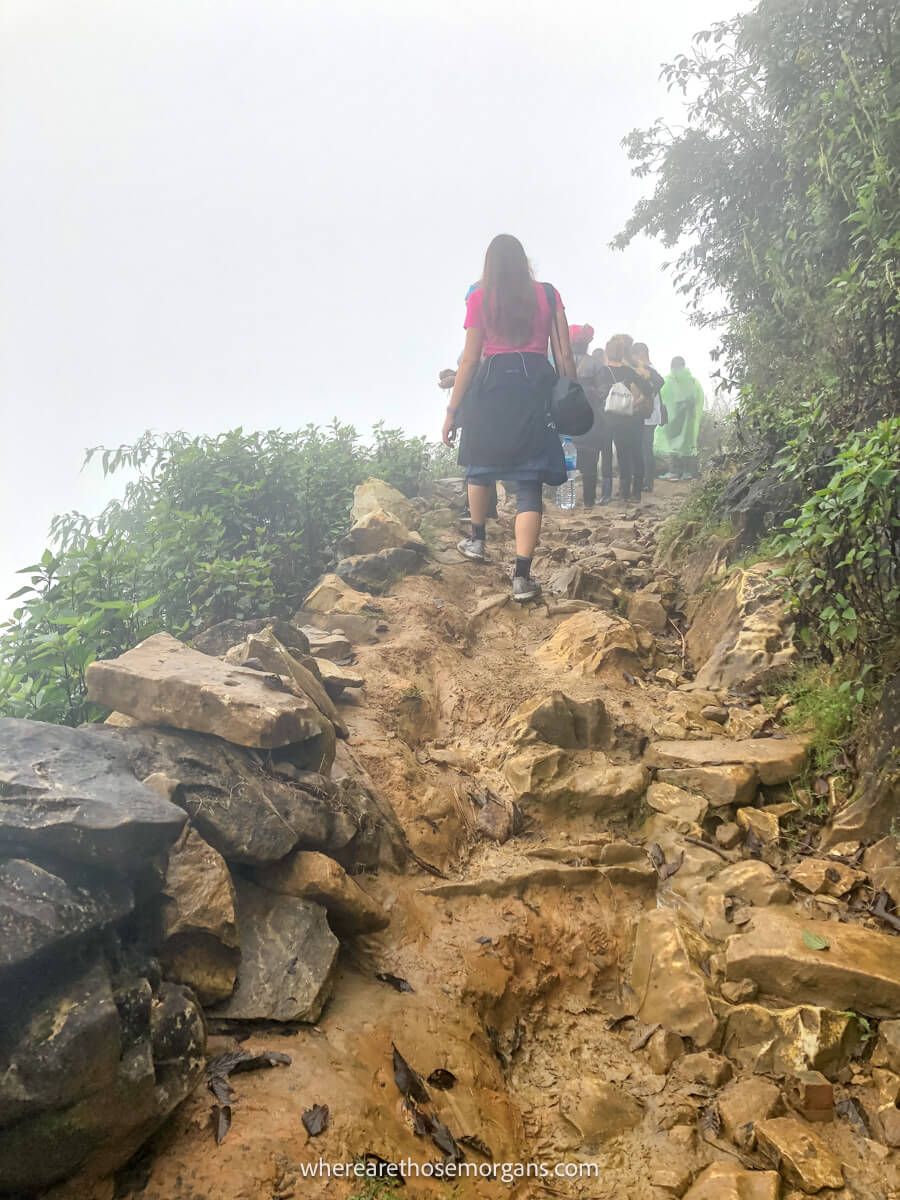
Sadly for most of the day, we were literally in a cloud. So don’t be surprised if that happens to you as the climate can be quite changeable in the surrounding Muong Hoa Valley.
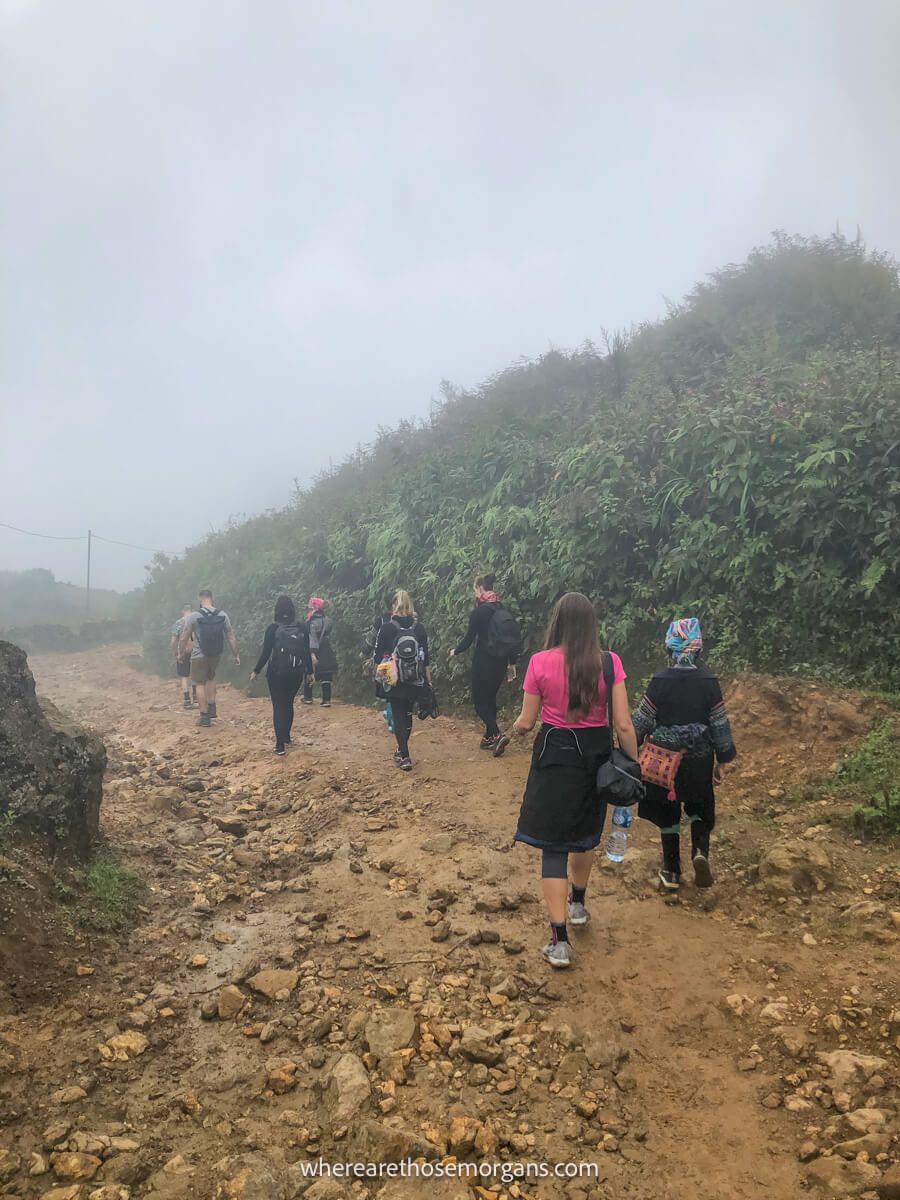
We met several other tourists trekking with their guides along the same route. Mama Sung stayed with us most of the time and we occasionally chatted with the others too. It’s a great place to meet like minded people, but it sometimes felt a little touristy, so don’t expect to be out there alone.

There was a stop for lunch in a busy canteen that seemed to appear out of nowhere, probably because it was raining so heavily and we couldn’t see. We chose the meat option, but there was a vegetarian option available too.
In addition to the rice, we were also provided a drink of water and a banana. Beer and other foods were available for an additional charge. The meal wasn’t amazing, but it was fuel for our bellies.
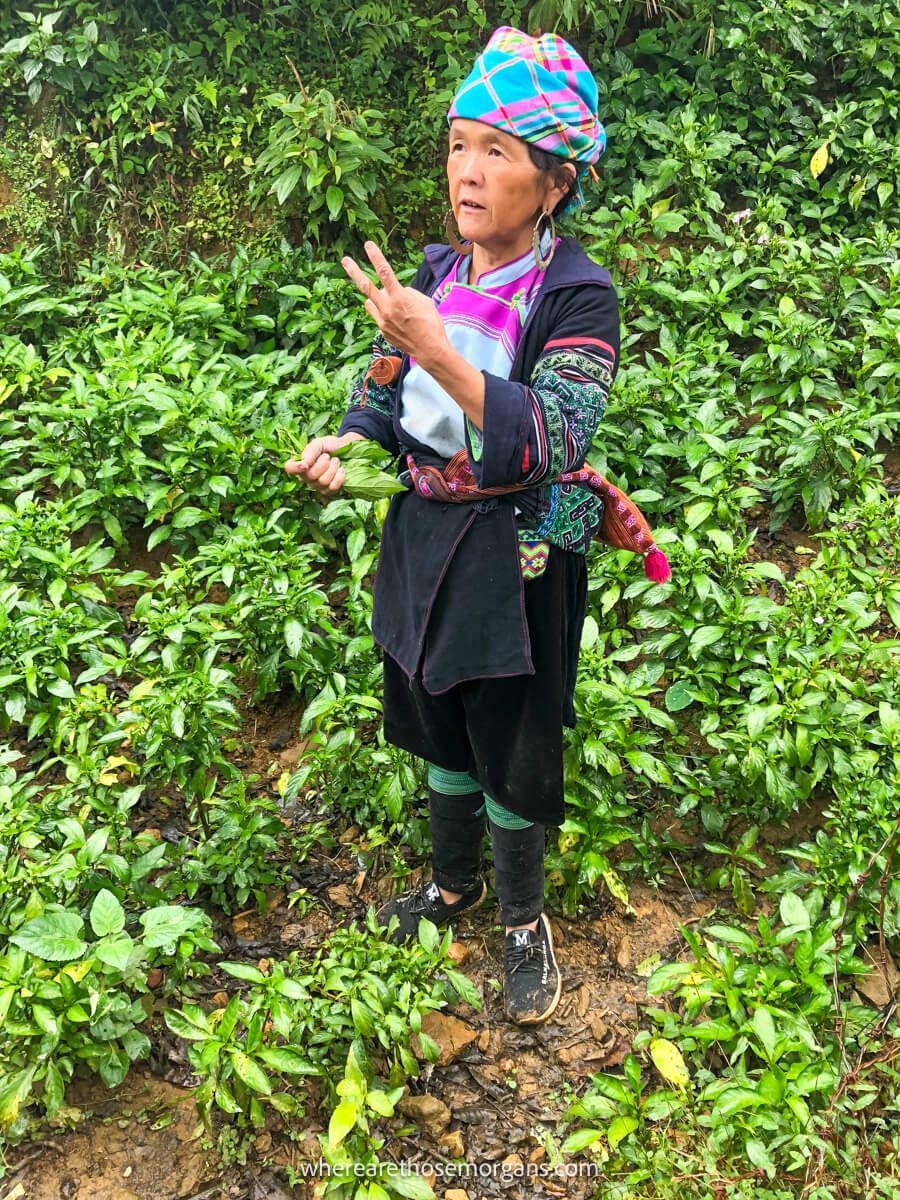
On a more positive note, we thought our guide Mama Sung was absolutely brilliant. She taught herself to speak English and loved to practice with us.
She also showed us how to recognize an indigo plant. Indigo is important to the Hmong people because they use it to dye their clothing. You can see some indigo on Kristen’s hand in the photo below.
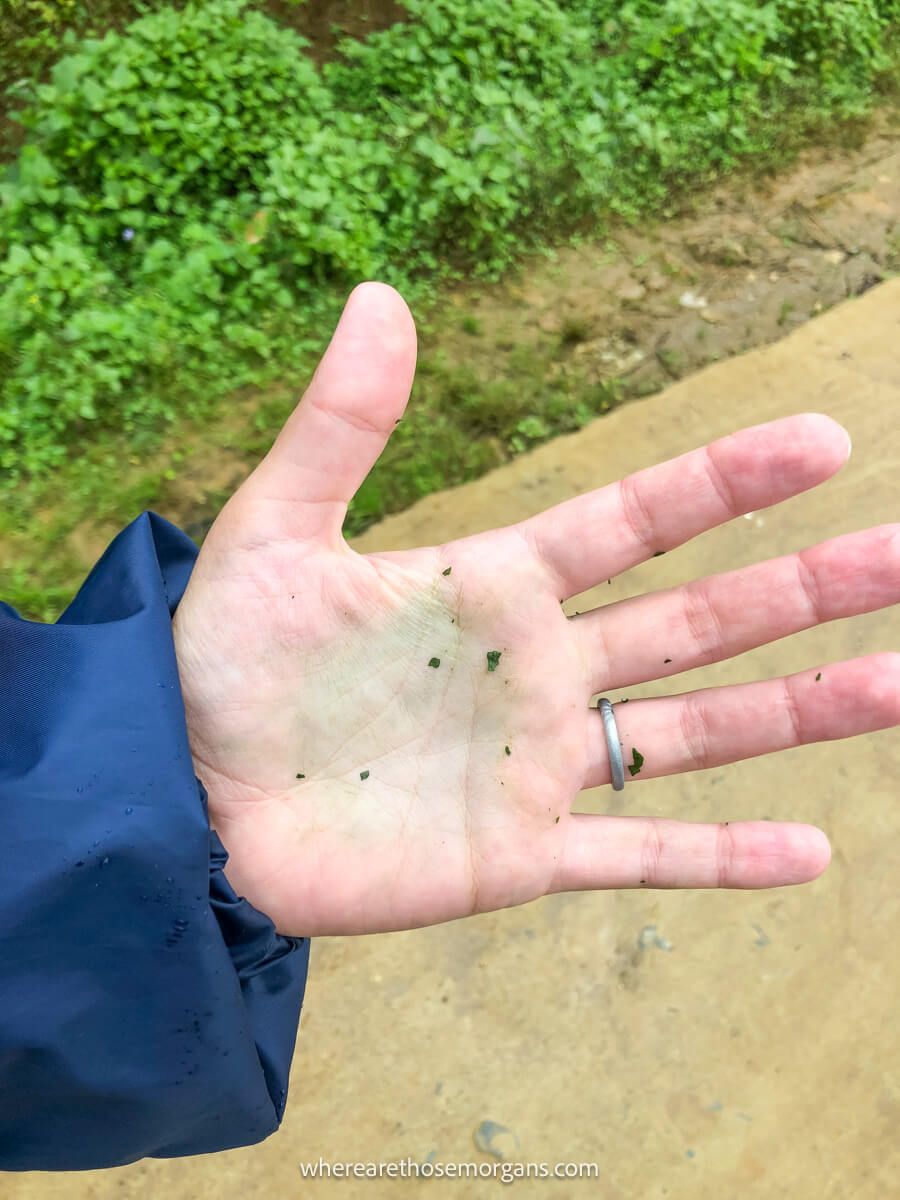
After about 6 hours of hiking, we eventually arrived into the village where we were shown to our accommodation for the night.
We found it interesting that we had to navigate through a skinny maze of paths to find where we’d be staying. These narrow paths were just wide enough for one person and one motorbike.
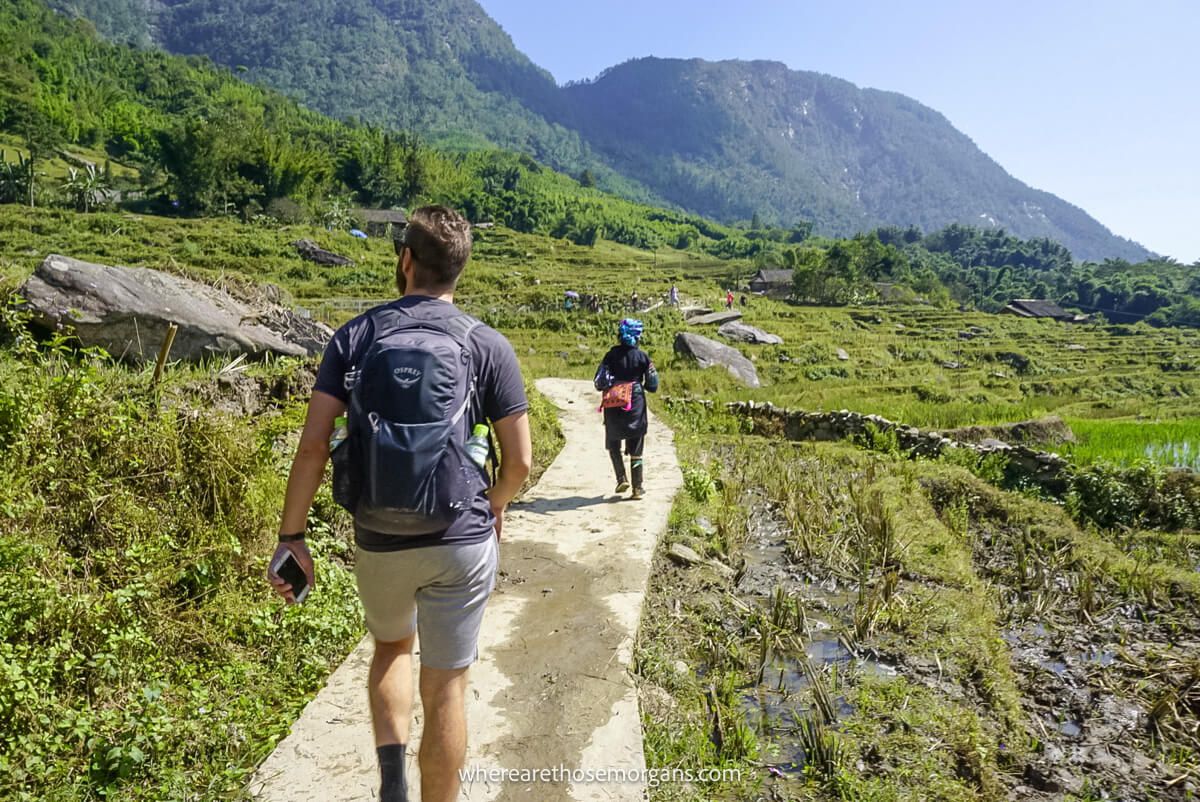
The set up for each homestay will be a bit different, but Mama Sung first showed us around her house as it was on the edge of the village and we met her husband.
Once we arrived in the main village area, she showed how the houses were built specifically around the rice terraces. Mama Sung also had a huge chart on the wall with pictures and the English word underneath. This was how she taught herself to speak English.

At this point, she told us wouldn’t be staying at her house, but at her cousin’s house nearby with several other tourists.
At first we were a little disappointed, but she lead us to a much larger building where we shared community spaces with 4 other people. However, we did have our own private sleeping quarters complete with mosquito net.
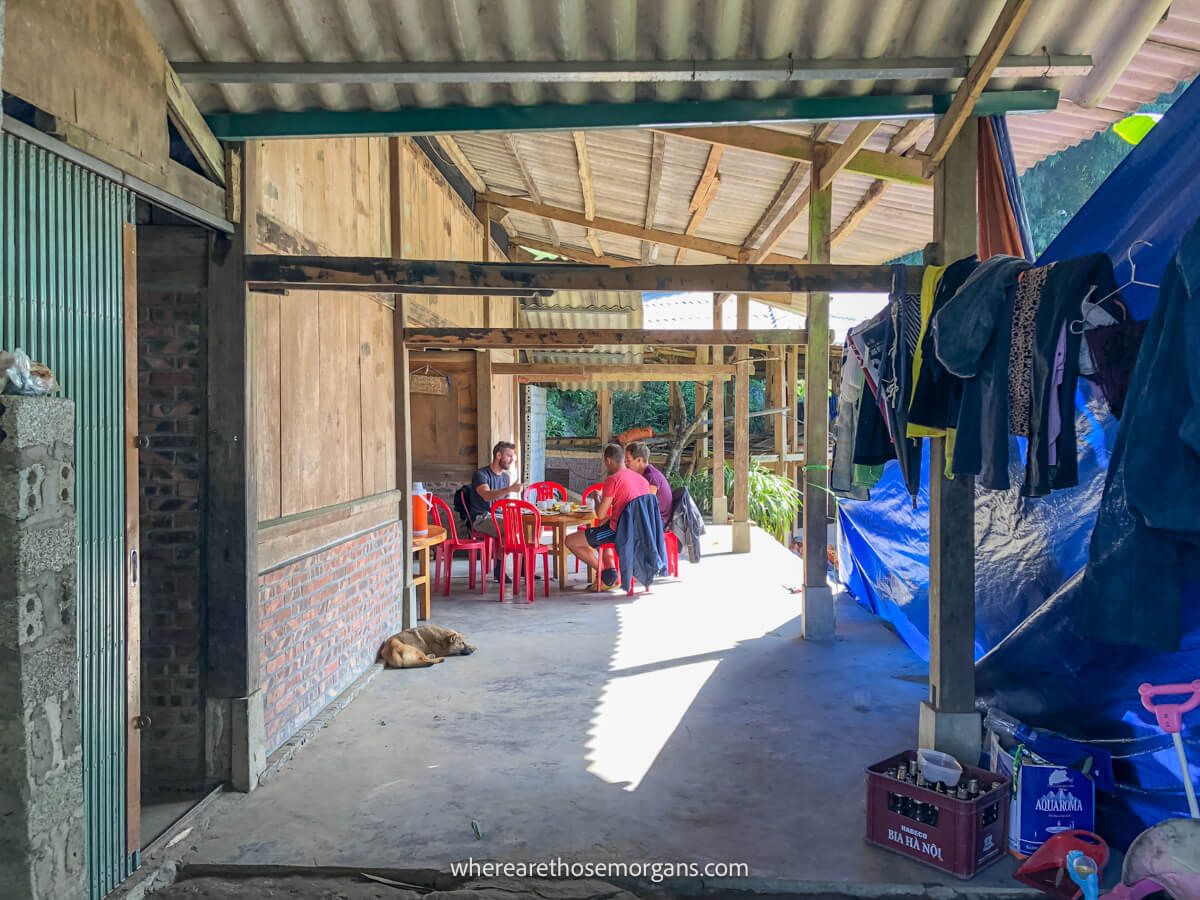
Maybe we just got lucky, but the other tourists in our shared house were great and we all got along well. For dinner, we all ate together with some of the other locals who were very friendly and spoke decent English.
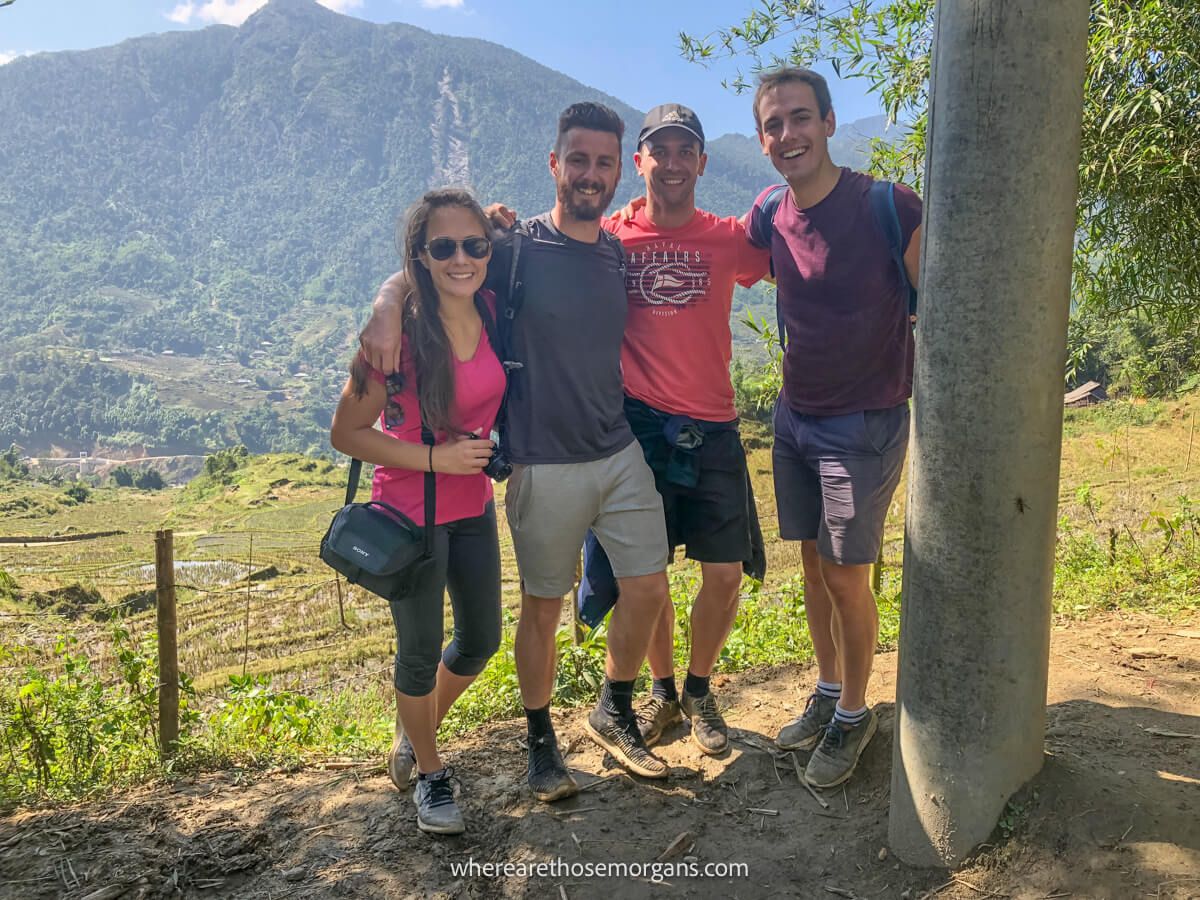
We were served dinner at 6:00pm and it was superb. The homemade spring rolls we had that night were some of the best we tried in Vietnam.
Our wonderful meal also included morning glory plus delicious chicken and vegetables with rice. It was such a drastic improvement over the subpar lunch.

After dinner, we all had a few beers and then Mama Sung brought out a clear plastic bottle that looked like it was the prototype of plastic bottles. She had been talking about something called “happy water” all day, singing it to us and laughing. And when she took the lid off, we quickly understood.
Turns out “happy water” is rice wine and it’s Vietnam’s most popular liquor made from distilled fermented rice. It packs a big punch and tastes like poorly brewed, slightly watered down tequila. But boy could the locals throw it back! Rice wine typically has a higher than 40% alcohol by volume and is often brewed by families at home. So if the happy water comes out during your homestay, get ready for it!
Trek Day 2
Needless to say, we all felt a little rough the next morning. But we all awoke in good spirits because it was such a great night. We were served a breakfast with thin pancakes, eggs and bananas along with a large cup of hot coffee. This meal was just as good as the dinner we had the previous evening.
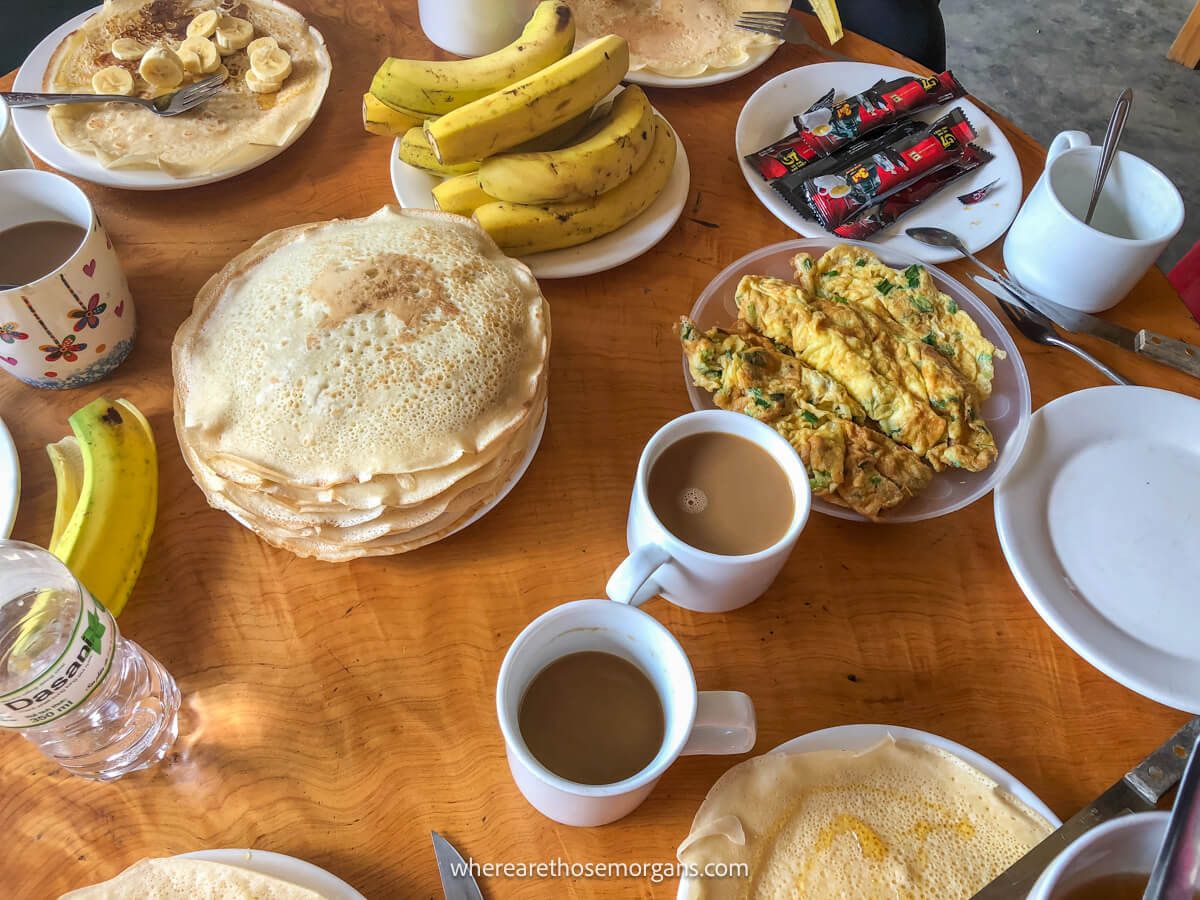
We preferred the second day of hiking because the weather was beautiful, the sky was clear and the sun was beaming which was a complete contrast to the day before.
We found the scenery and actual trekking to be more enjoyable too. Throughout the day, we ventured through the rice terraces, even though they were waterlogged and no longer golden.

It was pretty impressive to see 90° angled soil and grass spread out for miles like endless one sided green pyramids. We also passed several water buffalo cooling off in the rice paddies and they barely flinched when we walked by.
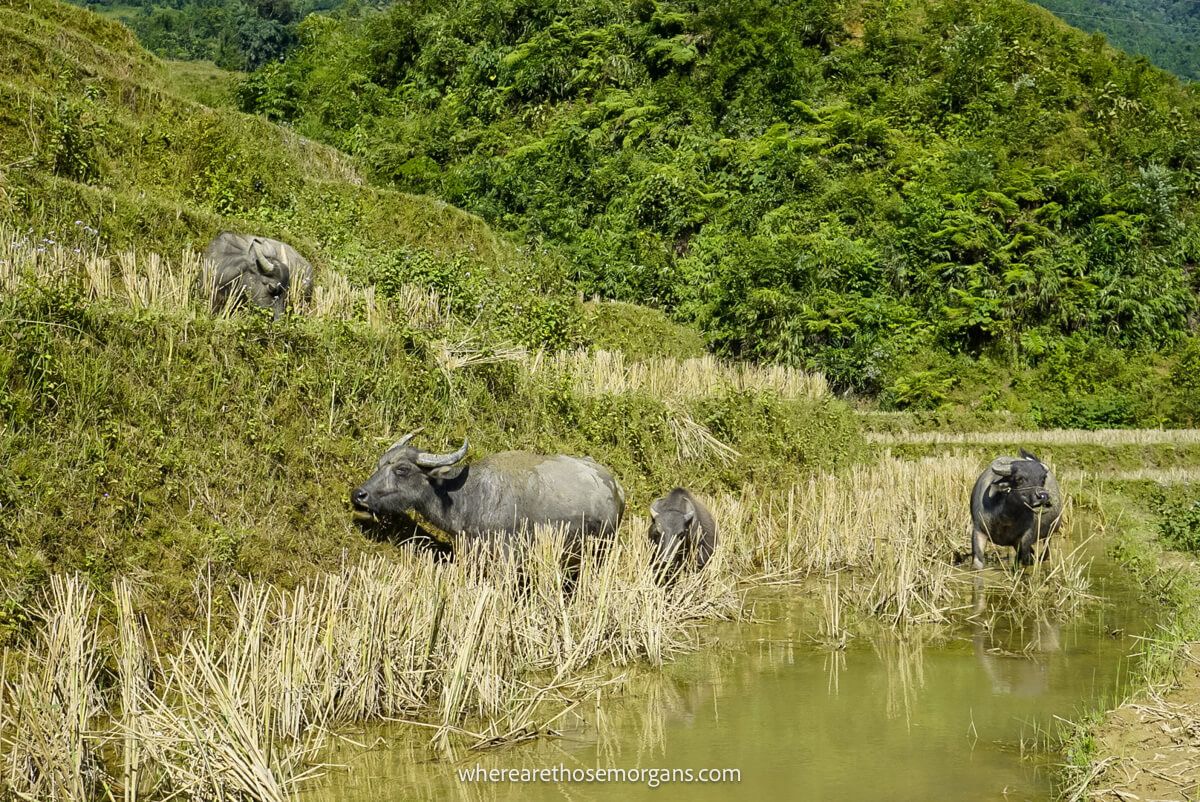
One of the points of interest we passed along the way was a dam being built. We had to walk along several rice terraces which wasn’t as easy as it looked because we had to balance along the edge. If we fell, we’d get soaked in the waterlogged rice paddy!
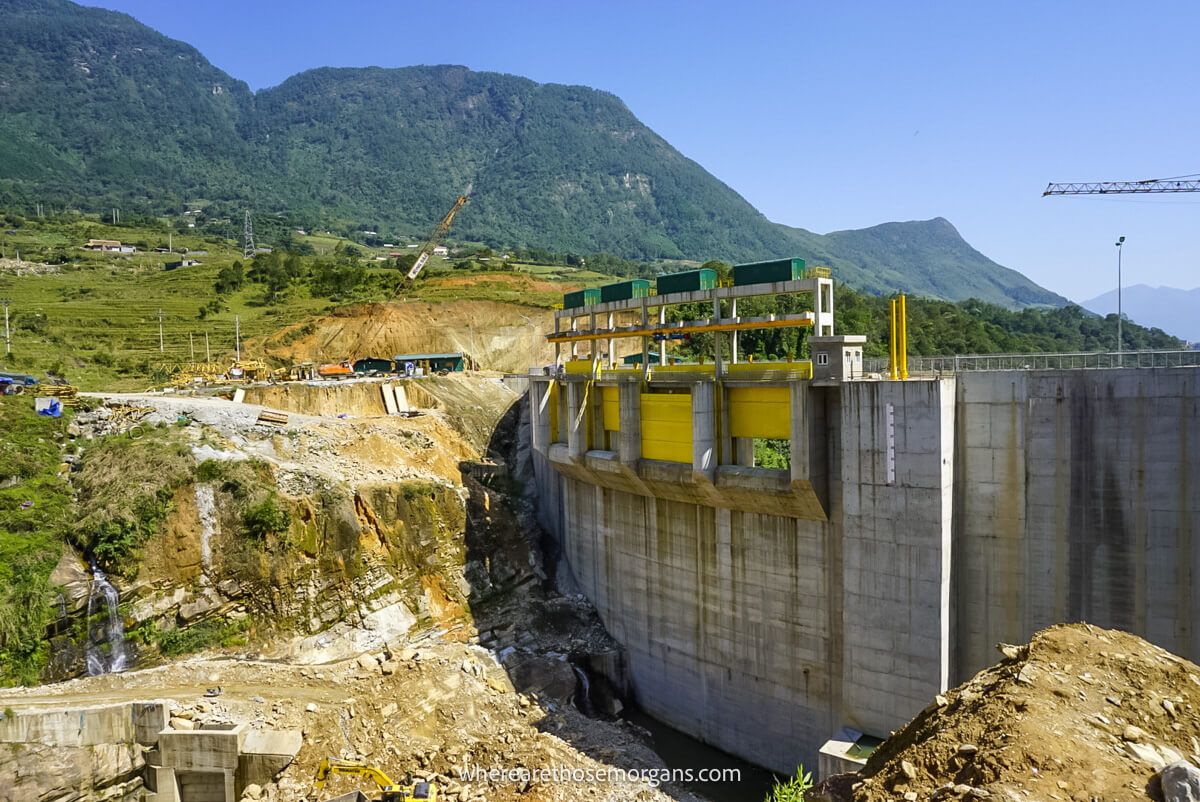
After a few hours of walking, it was time for lunch in a more hospitable wooden log cabin type canteen. The spot was right next to a waterfall and the sun was beaming down on us. There were a few groups all trekking together on the second day, so the route became a big happy family with many tourists and locals interacting.
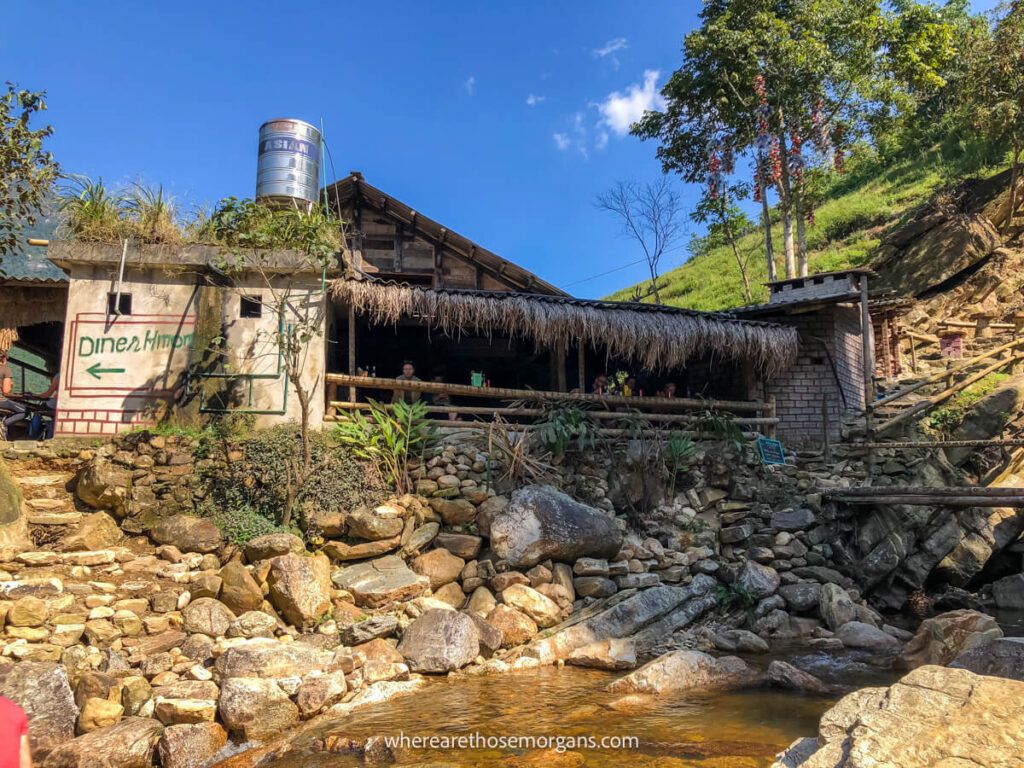
After another 6 hours of hiking, we were ready to head back to town for our transfer to Halong Bay. We said goodbye to Mama Sung along with the other fabulous guides and got picked up by a minibus.

Unfortunately, our bus got stuck for 1 hour when a huge truck was offloading material on the only through road. Definitely not what we wanted after a long day of trekking! But we finally got back to Sapa in the early evening.
Overall Thoughts About Our Trek
It’s difficult for us to say if you should book a trek in Sapa because travelers have varied experiences. That said, we enjoyed our trek and it’s a memory we always talk about. If this is something you want to do, we think it’s important you manage your expectations before setting out to hike.
Here’s what we liked:
- Ability to see the countryside with a guide so we didn’t have to worry about navigation
- Cool experience to see how the Hmong people live
- The hike was a decent work out and it was nice to be so active
- We met many other travelers from all around the world
- Sharing happy water with the locals was a really fun time
And here’s what we didn’t like:
- Visiting in late October meant the rice paddies were waterlogged
- Weather was hit or miss with both rainy and sunny days
- Some of the locals (mostly the men) were not very friendly
- Our first meal for lunch wasn’t great
- It felt a bit touristy at times
Our best advice is to ask as many questions as possible when booking a trek. While it’s easy to assume what will happen, it’s better to have a full understanding before you leave Sapa town. For example, we thought we’d be staying with Mama Sung by ourselves, but ended up staying the night with other tourists in a different building. It worked out in the end, but if you want a specific experience, make sure you’re clear.
Other travelers also complain about having a forced shopping experience which is not really something we encountered during our hike. We had a few children approach us as we left Sapa town, but it stopped once we reached the countryside. No one asked us to buy anything at our lunch stops either.
One of the most uncomfortable things we experienced was unfriendliness from some of the men in the local community. But after having a personal tour with a Vietnam war veteran a few weeks later in Hoi An, we learned the relationship between the north and south is still very complex.
The war consisted of communist northern Vietnam against the US and their anti-communist allies including southern Vietnam. So it makes for an awkward pairing now with the tourism boom in Sapa. No one actually bothered us, it just was an unpleasant vibe. But we think a smile goes a long way so we’d highly recommend being overly friendly for this reason.
How To Book A Sapa Trekking Tour
There are a few different ways you can experience hiking in Sapa depending on what you want to see. Here are your options:
- Book a combo homestay/trek like we did
- Book a homestay in the countryside
- Stay at a hotel in town and find your own hikes
Before booking, you should consider all of your options. Do you want to hike with a group? Do you want to go alone? Or maybe you want to visit multiple villages? To help you make the best decision, we’ve hand picked some of the most popular options.
Multi-Day Hike With Others
If you want to venture into the hills and spend the night like we did, check out the tours below. The first one includes transportation from Hanoi while the other 3 offer pick up anywhere in Sapa town.
Day Hike Option
If you’re short on time, you could also book a guide for a few hours of the day. These tours visit various villages or you can choose to climb Fansipan near Sapa.
Another great option is to book a homestay in a rural and more isolated location with fewer tourists. With this choice, you’ll stay with a local family and you’ll be able to independently trek around the valley if you want. More often than not, the families will pick you up in town which will be arranged beforehand. If not, you might need to hire a motorbike, take a taxi or walk to the homestay.
Here are top rated homestays in Sapa:
- Eco Hills Homestay – Public bath, restaurant, shared kitchen, free wifi, car rental and sun terrace
- Hmong Sister House and Trekking – Fishing, restaurant, free wifi, terrace and hiking guide available
- Hoa’s Homestay Sapa – Family rooms, 3 restaurants, room service, bar, terrace and clean rooms
- Hmong House Sapa – Shared lounge, pool table, private parking, free wifi, shared kitchen and tours
- La Beauté Sa Pa – Recently renovated, shared lounge, free wifi, coffee shop and tours
- My’s Homestay – Shuttle service, shared kitchen, free wifi, public bath, restaurants and tours
- Sapa’s Soul – Private entrances, sun terrace, restaurants, free wifi and tours
Travel Tip: For more homestay options, use booking.com. Filter by homestay and look on the map to the southeast of Sapa town.
The last option is to book a hotel directly in Sapa and find your own hikes. You can search for the best hikes on AllTrails here. Personally, we probably wouldn’t try to find hikes in Sapa on our own, but this may work for you. Without a local guide, it will be difficult to know where to go and you may be bombarded by people trying to sell you items if they see you walking along the roads alone.
Tips For Trekking In Sapa
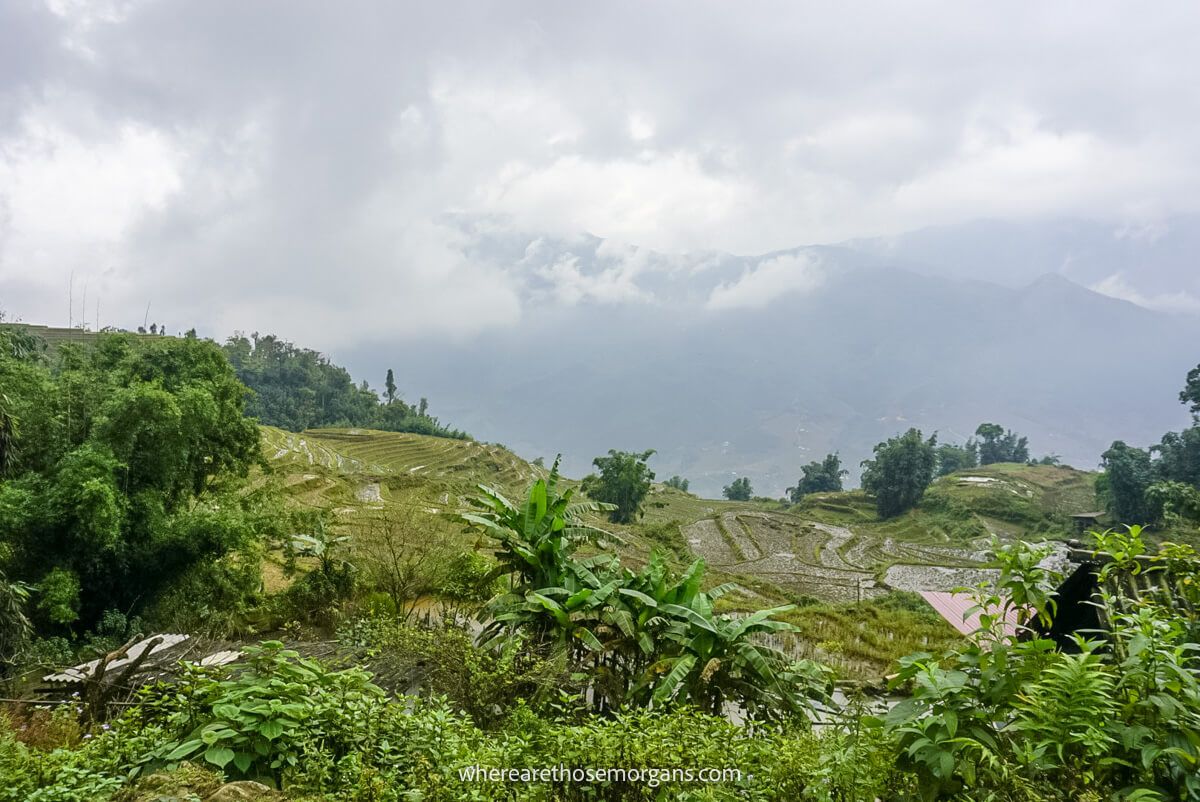
No matter how you book your Sapa trek, here are a few important tips for you to consider before visiting:
- Weather in Sapa is extremely changeable. One day could be beautiful clear blue skies with sun and the next day, Sapa will disappear in a cold cloud of water vapor. We added an extra day to our itinerary to account for bad weather.
- Bring the right clothes if you plan to hike. You’ll need hiking shoes, a raincoat, moisture wicking clothes and a small day bag. We also brought extra layers and socks in case we got wet.
- Leeches will be a real problem. We learned this the hard way and take note they’ll be more active after rainfall. In hindsight, we wished we brought hiking bottoms that covered our entire legs when we trekked in Sapa. Check for leeches regularly during your hike.
- You can book a tour online in advance or find one in town when you arrive. For the best experience, we’d recommend booking online because you can read other travelers reviews and you’ll know exactly what you’re going to get.
- Don’t forget sunscreen. If the sun decides to come out, you’ll be hiking in exposed areas for hours with minimal shade.
- Bug spray is also a must. Remember you’ll be hiking in the mountains and you’ll need bug spray to avoid getting eaten alive. We brought some and ended up sharing with the whole group who we’re extremely grateful.
- You can usually keep items at your previous hotel if you plan to trek. We’d highly recommend doing this to lighten your load. Just be sure to confirm before booking your hotel.
- Hiking in Sapa is moderately difficult. If you book a typical trek, you’ll walk about 7 to 10 miles for about 6-8 hours per day. Most of the treks follow roads with steady elevation gains so the hardest part is the distance.
If you need to find a hotel before and after your guided tour in the Sapa valley, our recommendation would be to book something centrally located near Sapa Lake in the middle of downtown. This location is close to many restaurants and it’s where you’ll probably meet your guide. One of our favorite restaurants was Le Gecko which has an extensive menu and excellent service. Many travelers congregate here so it’s also a great place to meet others.
We stayed at the Olympia Hotel and paid 1,600,000 VND (about US$ 70) total for both of us for the hotel and to experience a 2 day Sapa trekking tour. If we were to return to Sapa, we’d book a nice homestay out in the countryside for a few days instead.
More From Vietnam
- Best places to see in Vietnam
- How to spend a few days in Sapa
- An epic northern and central Vietnam itinerary
- How to spend 10 days in Vietnam
- The perfect Hanoi, Vietnam itinerary
- Tips for traveling from Hanoi to Halong Bay
- What to see in Phong Nha, Vietnam
- Cool things to do in Ninh Binh, Vietnam
- Amazing things to experience in Hoi An
- How to find the best Halong Bay cruise
- One months in Vietnam expense report
- How to drive the famous Hai Van Pass
Want more Vietnam content? Head over to our Vietnam Travel Guides to see example itineraries, tips and popular city guides.
We hope our guide to trekking in Sapa helps you plan your own successful trip through the Muong Hoa Valley!
Please let us know if you have any questions in the comments box a little further below.
Happy Trekking,
Mark and Kristen
Enjoy this guide? Pin it for later!
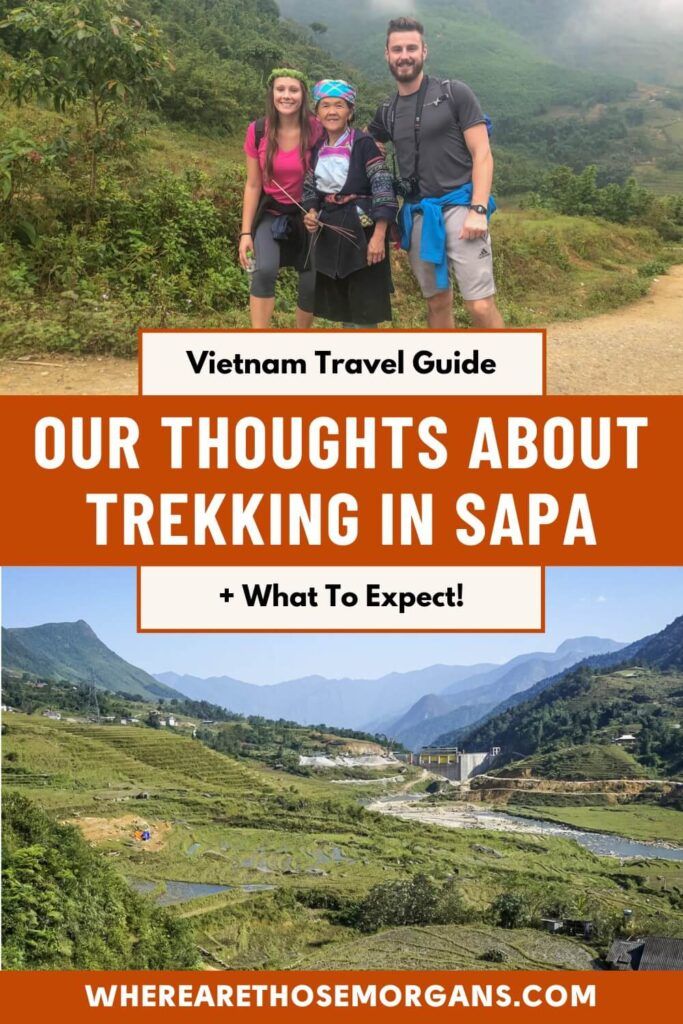
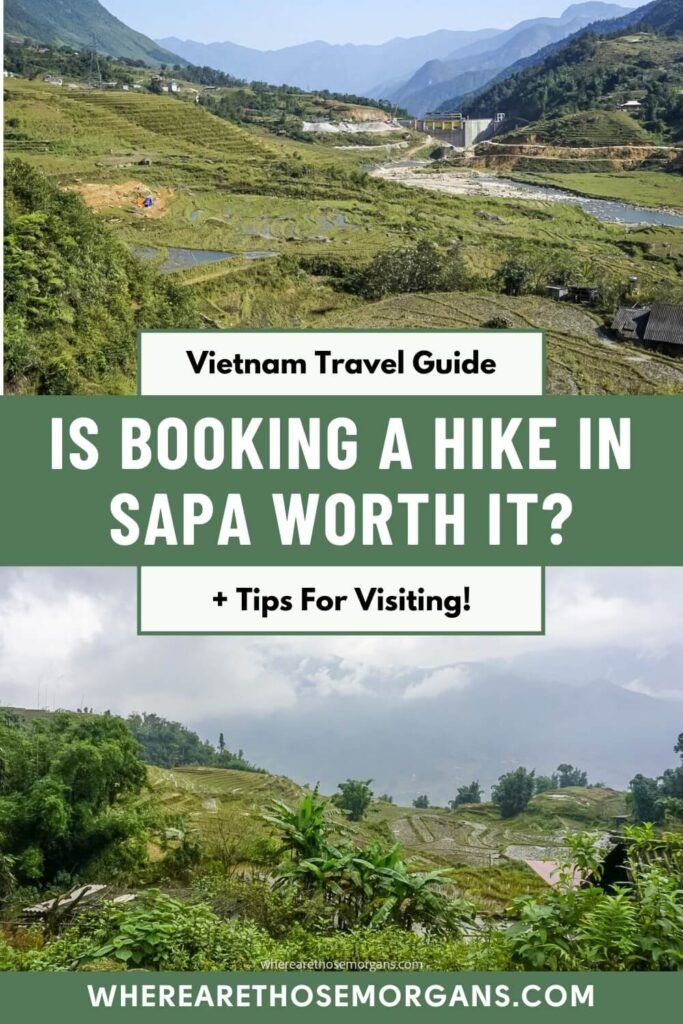
All Rights Reserved © Where Are Those Morgans, LLC. Republishing this article and/or any of its contents (text, photography, maps, graphics, etc.) in whole or in part is strictly prohibited.

